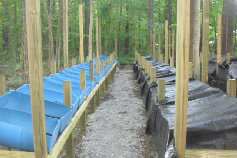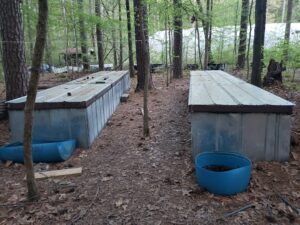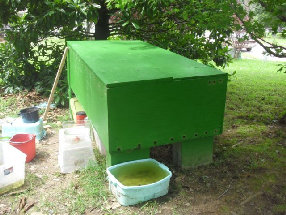Easy ways to raise Redworms
– Redworms are the easiest worms to raise
– Peat moss, feed and water… or compost and water.
All the Key essentials to know about raising worms are in the video below. Everyone should watch the following video before they purchase worms.
Containers and Bedding for Worms:
– Big buckets, half buckets – concrete mixing pans, plastic, metal, ceramic, or wooden containers can all work
– Put small drill holes (5/32nd) in bottom to drain excess water out of bedding and cover with set sand to
prevent the worms from slipping through the holes
– ½ Barrels – cut either way – Good year around in most of the south (I am just 8 miles south of the TN
border)

– Pits/In ground beds – make them 24 inches deep – Great year around (Especially good up north)
– Put 4 inches of gravel in the bottom to keep moles out. Cover gravel with planks or horticultural ground-cloth.
Construct with block or sheet metal. If you use treated wood to attach the sheet metal to be sure to paint the wood to prevent contact with the bedding.

– Bath tubs, big flower pots, old refrigerators or freezers
– Concrete blocks – build like a raised garden bed
– Build a wooden box – don’t use pressure treated wood, it could poison the worms and compost
– Make sure the container will drain. Worms like it wet…even very wet, but you can ‘drown’ the worms
– Technically worms don’t have lungs and can survive a while in water, but left too long will die
– Keep them in shade or in a building or basement (mine are all under trees)

– 6 – 12 inches of bedding – damp peat moss works well. Soak peat moss for a day or 2 before using
– Squeeze dry until just a few drops come out or put in container and let drain a day – then add worms
– You can mix cotton hulls (lofty) and well composted horse manure with just a bit of sand (more on this in my guide).
– Cover any beds that are outdoors and not protected from pests
– Pits and containers in a building or barn protected with screen or chicken wire may not need covering
– Feed sacks, and cardboard work for cover and the worms will start eating them too
– I cover my worms with horticultural ground-cloth I buy at a local feed store with plywood or poly panels on top of that.
– Bedding should be changed every 4 – 6 months. Old bedding is by far the best compost you can get.
– Either blow air through the bottom of the beds of turn the beds over (gently so as not to harm the worms) every couple of months to aerate the beds. This helps prevent the growth of foul anaerobic bacteria. Worms like looser bedding too!
Feed for Worms:
– Any well composted manure, Use ‘green’ (fresh) manure sparingly (see note below)
– Rabbit manure makes great worm feed too – worms LOVE it! They grow like crazy in it!
– If you need rabbit manure, ask at the feed store who’s buying rabbit feed, you may get it for free or buy it from them
– Rabbit feed makes a good worm feed too
– Try not to cover your whole worm bed with feed, if the feed heats up the worms need a place to back away (see note)
– Some feed stores have worm feed (cheaper alternatives are below)
– Chicken laying mash crumbles, or chick starter. (The only feed I actually buy. I buy it non GMO)
– Wet paper and cardboard…keep it wet and in small pieces…
– Grass clippings
– Coffee grounds and filters
– Anything that composts, smaller pieces are better
– Avoid dairy, and meat scraps as they could stink and draw pests, avoid onions, citrus fruit, and hot pepper as they can irritate the worms due to acid and spice content
– Sprinkle a little sand on the bed of mix it in with the bedding, worms have gizzards to grind food like a bird. Baby worms will not survive without it.
Note: Feed lightly as overfeeding can result in uneaten food which can spoil and turn acidic. If the bedding is too acidic it can harm or even kill the worms. Too much feed (especially if buried) can go into a heat which can kill worms. (This may be okay during times of a hard freeze if the feed or fresh manure is limited to a discrete trench within the bed to provide some heat.) To control acid add egg-shells (best if blended into a powder or wet slurry) and maybe lime. When using lime be sure to use pure pulverized limestone, as hydrated/slacked (a.k.a. builder’s lime) or chemically treated lime that is often used in gardens can harm or possibly kill the worms. You can use Borax. Just tell them what you really need at any feed-store. You can get pH test strips and meters at most garden centers.
Random Thoughts
– Worms are top feeders, and if your worms are crawling away at night or during thunderstorms
– put a light (40 watt) over the bed…these are lazy worms and I’ve never had much of a problem
– New worms in a bed usually don’t eat the first few days, they are just getting used to their new place
– Worms will double in numbers every 60 – 90 days… So… Go fishing or build more beds
– Worms can also be a great part time/full time income
– Worm castings is a great natural fertilizer
– Worm tea is an all natural liquid fertilizer and pest repellant
If you have any questions…I’m usually in the house after dark, central time, North Alabama.
– just call me at: 256-859-5538 – If I don’t answer just leave a message (and plainly state your phone number as this is a land line phone). Please call between 9 AM and 10 PM central time, or email me at: Greg@GreenGregs.com
Redworms have been good to me and I hope you’ll:
Give redworms a try.
Best ‘O Luck!
Greg Allison
Green Greg’s Garden and Worm Farm
112 Stilwell Dr.
Toney, AL 35773
256-859-5538
